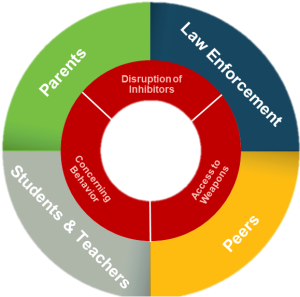This site uses cookies to provide you with a more responsive and personalized service. By using this site you agree to our use of cookies. You can learn more about our use of cookies and similar technologies and your choices by reviewing our Privacy Policy. By clicking “I agree” you agree to our use of cookies and similar technologies.
Spotting Red Flag Indicators
According to the FBI’s Pre-Attack Behaviors of Active Shooters from 2000 to 2013, 92% of attackers who were students at the time of the attack exemplified concerning behaviors. Overall, the FBI concluded that for every active shooter event, at least one person noticed the concerning behavior, yet no action was taken; therefore, the opportunity for intervention was lost.
A number of reasons exist for why these behaviors are not reported, including fear of labeling a friend or family member as an active threat, concerns about retaliation, or uncertainty regarding law enforcement response. Barriers can be broken down by educating community members to spot indicators of impending violence and encouraging them to report red flags.
Concerning Student Behaviors
Today, schools are asking what constitutes concerning behavior as they try to protect their schools while preserving student privacy and rights. According to the FBI’s study, the most frequently occurring concerning behaviors were related to mental health, problematic interpersonal interactions, and leakage of violent intent. At the same time, a significant number of school attackers have been described as quiet, reserved, and isolated. Many people might have concerns about labeling someone unfairly as a threat for this personality trait alone. The FBI’s study, however, shows that on average, active shooters demonstrated 4.7 distinct concerning behaviors.
While the FBI’s study provided valuable key insights on identifying pre-attack behavior, the focus was not on student attackers, which accounted for 19% (12 of the 63 attackers) studied.
Based on research from media, law enforcement, and government resources on active shooters targeting schools around the globe, Guidepost Solutions has developed the following list of concerning behaviors:
- Suicide attempts or suicidal ideation
- Fascination with firearms or weapons
- Fascination with school shootings (particularly Columbine)
- Anger management issues
- Indications of mental health issues
- Inconsistent work with a mental health professional
- Isolation from peers
- Involvement in online forums promoting discussion of violence
- Leakage of attack plans or intent
For 90% of active shooters assessed in the FBI’s study, the first instance of concerning behavior occurred at least three months prior to the attack. For 56%, the first instance of concerning behavior occurred at least two years prior to the attack. The lesson here is that many active shooters show indicators far in advance of their attacks.
According to the FBI, for active shooters under age 18, school peers and teachers were more likely to observe concerning behaviors than family members. For 92% of student shooters, a schoolmate noticed the concerning behavior.
Attack Inhibitors
School Threat Assessment Teams would be well-advised to track not only concerning behaviors but also inhibitors to violence. These include fear of consequence, intact family structure, friends, involvement in extracurricular activities with peers, lack of access to weapons, intact mental health support system, and future prospects.
When an inhibitor is no longer present, it must be documented. While the below items do not necessarily predict violence, they can serve as a violence enabler:
- Death of a parent(s) or close relative
- Divorce or separation of parents
- Unstable home environment
- Withdrawal from extracurricular activities
- Withdrawal from peer groups or friends
- Seclusion with one friend, rather than a circle of friends
- Expulsion or suspension
- Ceasing counseling sessions
- Refusal of prescribed medication
- Turning the legal age to obtain a weapon
Attack Observation Rings
There are three observable elements to a school attack: concerning behavior, disruption or lack of inhibitors, and access to weapons.
While there can be overlap, we generally recognize the potential observers as:
- Students or teachers can be observers of concerning behavior based on the significant time spent at school or school activities.
- Parents are the most likely observers of disruption of inhibitors as these often relate to the home environment.
- Peers and law enforcement are better observers of access to weapons than parents, but parents can divulge if weapons are kept in the house. In this context, peers can relate to both in-person and virtual friends or acquaintances.
Educating Observers on Reporting Concerning Behavior
While educating parents and teachers about detecting these elements is important, the most important groups that need active awareness and training are students and peers. Young people need to take threats of violence seriously and be aware of concerning behaviors. In order for peers to feel comfortable reaching out to their parents, administrators, or law enforcement, a process must be in place to assess the threat, keep the anonymity of the reporter, and generate a productive response
When the Guidepost Solutions team works with schools, we advocate for a multidisciplinary threat assessment team composed of school administrators, counselors, law enforcement, and mental health professionals.

Angela Osborne CPP, PSP, PCI
Associate Vice President, Risk + Emergency Management Solutions
Angela J. Osborne, PCI, PSP, CPP specializes in emergency management planning, security risk assessments, and physical security assessments. She has worked with clients in diverse sectors, including education, government, healthcare, legal, energy, manufacturing, and commercial real-estate.



